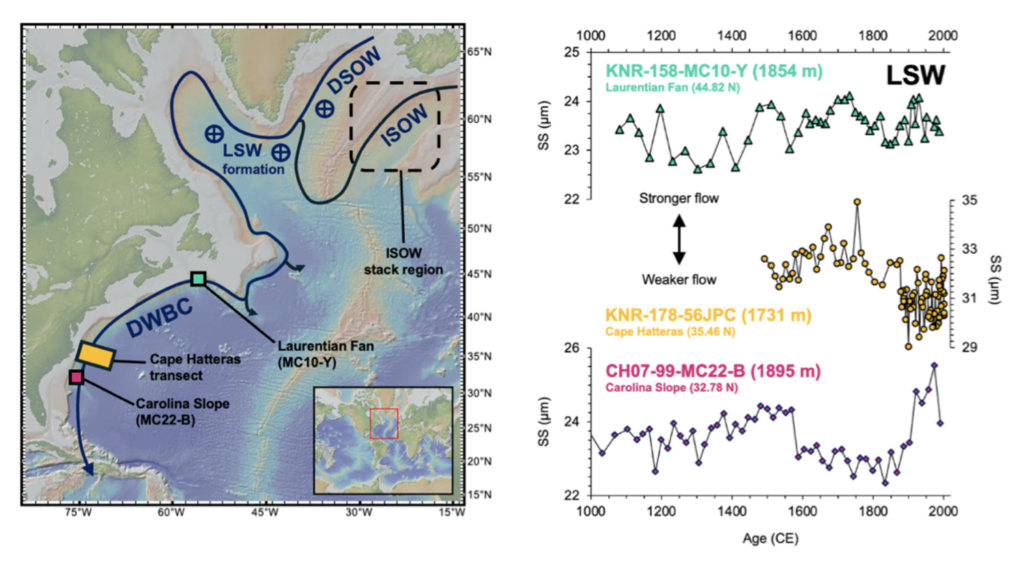Deliverable 1.1: Palaeo proxy records
Modern observations spanning the past two decades suggest that the Atlantic Meridional Overturning Circulation (AMOC) has weakened at a rate of ~0.1 Sv/yr. However, since these observations are limited to the last ~20 years, indirect observations from ‘paleo proxies’ preserved in marine sediments are necessary to constrain past AMOC variability beyond the instrumental record (see here for an explainer).
While numerous paleo-reconstructions suggest that the observed current AMOC weakening is part of a longer-term trend starting approximately 150 years ago, inconsistencies exist between paleo and modern proxies, as well as between proxies and coupled models.
Furthermore, there is also a distinct lack of deep ocean records corresponding to the deep limb of the AMOC, i.e., the Deep Western Boundary Current (DWBC) and its constituent currents, such as Labrador Sea Water (LSW). To address these issues, we have generated new records of sedimentary grain size and benthic foraminiferal δ18Oc, proxies for deep ocean flow speed and temperature1 respectively, from multiple sites along the path of the DWBC during the Holocene (~11.7 ka BP to present), with a particular focus on the last millennium. These new records will not only will enable us to better quantify past AMOC variability (WP1), but they will also feed directly into EPOC’s work on explaining AMOC changes (WP3), where we will perform a systematic re-evaluation of different paleo proxies used to reconstruct AMOC variability by comparing them to a suite of different AMOC transport simulations.
In Deliverable 1.1 we compile, present, and provide an examination of these newly generated and previously published deep ocean proxy records from the Northwest Atlantic. The main findings are summarised below.
1. The last millennium
- Grain size records of LSW exhibit notable changes post ~1800 CE compared to the last 1000 years (Figure 1).
- Grain size records corresponding to Iceland-Scotland Overflow Water (ISOW) from South of Iceland to Cape Hatteras also exhibit major changes post ~1800 CE, particularly a decline in inferred flow speeds, suggesting ISOW flow may be somewhat latitudinally coherent on multi-decadal timescales.
- Benthic foraminiferal δ18Oc records from the North Atlantic all generally exhibit similar behaviour over the last 1 ka, namely a long-term decrease prior to ~1700 CE, followed by a more abrupt increase. However, the exact timing of this change varies between cores from the Iceland Basin and the Northwest Atlantic, e.g., Cape Hatteras.

2. The Holocene
- On millennial timescales, grain size records corresponding to LSW flow speed variability generally show a long-term increase over the last ~8 ka.
- Building on previous work, we infer that ISOW strength has decreased over the last ~8 ka, while also experiencing persistent shorter-term variability.
- Grain size records from depths corresponding to ISOW and Denmark Strait Overflow Water generally show differing behaviour between Cape Hatteras and regions closer to each water mass’s source, i.e., South of Iceland and the Labrador Sea respectively.
- This highlights that on longer timescales there have likely been vertical shifts in the positions of all three major water masses, an aspect that is important to constrain when looking at models and proxy data on millennial timescales.
1Although salinity also controls benthic foraminiferal δ18Oc, we assume that temperature is the dominant control in the Northwest Atlantic over the last 1000 years.
Want to learn more?
The full D1.1 report will be available once it has completed the review process
